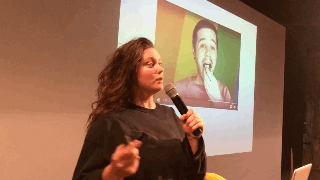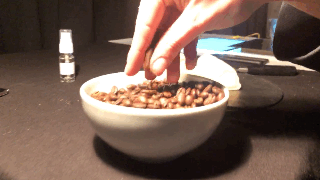What we see, hear, taste, smell and feel forms our sensory perception of the world around us. In Marketing, multi-sensory experiences are used in order to create the desired brand image in the mind of the potential consumer. With the sensory perception come emotions – think of how the look and sound of coffee beans remind you of pleasant mornings on the weekend or the smell and texture of cheese make your mind travel back to your last holiday in France.
With this in mind, we conducted some experiments while recording live stream videos of lectures here at Mediamatic – with the primary goal being to engage with our audience at home in front of their screens and stimulate their senses and imagination.
When filming, make sure you move. The audience is most likely not joining the live stream only to be looking at a PowerPoint presentation. Offer insights and unexpected angles, such as filming from the speaker’s point of view. Or accompany an on-site guest entering and leaving the lecture with your camera for a more inclusive experience.
The use of light helps further in creating a dynamic setting. You want to use different lights for the speaker and the on-site audience. Also, what looks good on the projection screen in the room might appear different when filmed and watched on the screen at home. Try other presentation formats (4:3 vs 16:9) and layouts – white text on black background looks utterly different from black text on white background.
Have you ever joined a live stream event online? They tend to become long and tiring. We tried including little surprise moments for the audience at home by playing around with a second location.
A studio set-up in the back corner of the lecture room provided supporting sensory experiences for everyone joining online. How do coffee beans sound when touched, and what do they look like in a close-up shot? What does the viewer think of when looking at different cheeses being cut gently by a sharp knife?
When observing those items, does a white background make them feel different from a black background? Will the audience at home feel cold if you film an arm with goosebumps? And what happens if you add an unexpected sound to the cheese-cutting and coffee-stirring? Those are just a few thought-starters. You can make the experience even more disruptive by covering your camera when switching between scenes and situations.
Creating events and lectures for both on and offline audiences comes with challenges, but it also comes with great opportunities for new and creative approaches. An online experience does not replace an on-site event, but it can provide new stimuli and ways of communicating and perceiving content.


